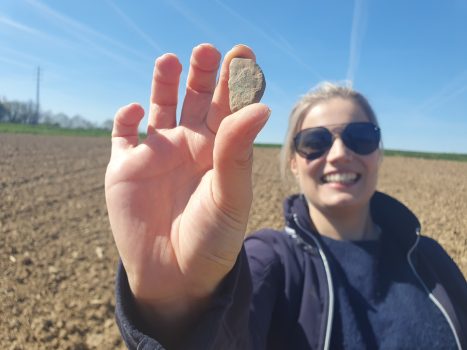Semisses from Colonia Nemausus
- Date of discovery: 2025-04-06 and before
- Aproximate location of discovery: Neerlanden, Vlaanderen
- Context: Fragments of terra sigillata, tegulae, imbrex
These small bronze coin fragments are semisses. Not originally struck as such, but created by cutting a larger Roman coin, typically an as or dupondius, in half. These improvised semisses were commonly used in Colonia Nemausus (modern-day Nîmes, southern France), a Roman settlement that flourished under the early Roman Empire. The coin’s origin is attested by its distinctive imagery: often bearing the conjoined busts of Augustus and Agrippa on one side and a crocodile chained to a palm tree on the other.
Colonia Nemausus:
Founded as a veteran colony after the campaigns of Julius Caesar and Augustus, Colonia Nemausus was strategically located in Gaul and became a symbol of Roman authority and cultural integration. Around 10 BCE, the city began issuing its own bronze coinage—most famously the so-called “Crocodile Coins.” These coins were locally produced and widely circulated in the region for many decades, long after official minting ceased.
Col Nem coinage:
The obverse of these coins typically depicts the back-to-back busts of Augustus, Rome’s first emperor, and Marcus Agrippa, his close ally and general. This pairing emphasizes the joint military and political leadership that secured Roman dominance. The reverse shows a crocodile chained to a palm tree, symbolizing Egypt’s conquest in 30 BCE and Rome’s victory over Cleopatra and Mark Antony. The imagery ties provincial Nemausus to Rome’s global victories and imperial authority.
From as to semis:
Full-sized asses and dupondii from Nemausus were relatively heavy, and in daily life, smaller denominations were often required for minor transactions. Rather than striking new coins, locals would sometimes cut these coins in half, creating what we now call semisses (half-asses or half-dupondii). Though unofficial, these halved coins were accepted in local commerce, reflecting the economic improvisation and autonomy of Roman provincial life.
